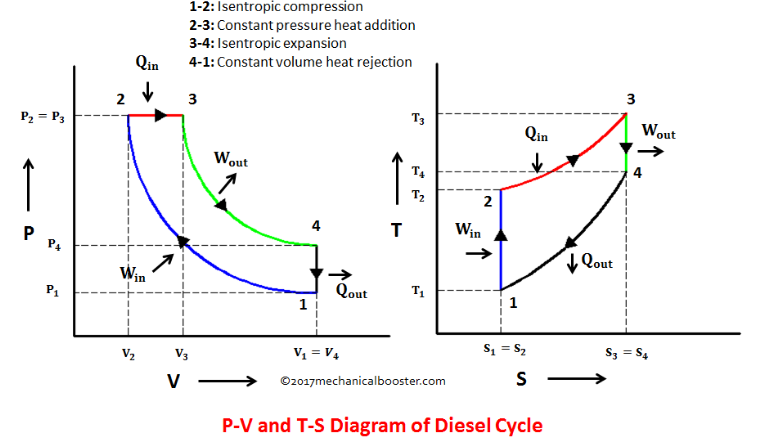An Otto cycle is an ideal thermodynamic cycle that describes the function of a spark ignition piston engine. The idea of Otto cycle was first proposed by Nicolas Otto back then in 1876. It is the thermodynamic cycle most commonly found in automobile engines. It describes what happens to a mass of gas as it is subjected to changes of pressure, temperature, volume, addition of heat and removal of heat.
Diesel cycle is a gas power cycle invented by Rudolph Diesel in the year 1897. A diesel cycle is an ideal-engine cycle during which the working substance successively undergoes adiabatic compression, constant-pressure heating, adiabatic expansion, and then constant-volume cooling. Diesel cycle is similar to Otto cycle except in the fact that it has one constant pressure process instead of a constant volume process.
Diesel engines are used in aircraft, automobiles, power generation, diesel-electric locomotives and both surface ships and submarines.
Key Differences
Otto Cycle
- The idea of Otto cycle was first unveiled by Nicolas Otto back then in 1876.
- Otto cycle uses the spark plugs to light the charge, which is a mixture of air and fuel.
- Petrol engines work on principle of Otto cycle whereby to supply the fuel into the combustion chamber Carburator is used.
- Otto cycle works on four processes, which are intake stroke, compression stroke, expansion stroke and then exhaust stroke.
- In Otto cycle the heat addition takes place at constant volume.
- The overall efficiency is way less than that of diesel cycle.
- The charge is drawn in by the cylinders during the intake stroke.
- Adiabatic expansion takes place during the backward stroke of the piston.
- It has compression ratio from 7:1 to 10:1 which is lesser than that of a diesel cycle.
- It has a high thermal efficiency when compared to Diesel cycle.
- In Otto cycle, at the time of heat addition, the piston is at Top Dead Center (TDC).
Also Read: Difference Between Carnot And Renkine Cycle
Diesel Cycle

- The diesel cycle was proposed by Dr. Rudolph Diesel in 1897.
- The diesel cycle does not require any assistance to get ignited, this because it has a high compression ratio that does not allow it to depend on any plug for the charge.
- Diesel engines work on the principle of diesel cycle whereby fuel injectors are required to supply fuel into the combustion chamber.
- The diesel cycle works on four different processes which are adiabatic compression, heat addition, adiabatic expansion and then heat rejection.
- Heat is added at constant pressure.
- The overall efficiency is higher than the Otto cycle.
- In the diesel cycle, the adiabatic expansion takes place when the heat addition is cut-off.
- It has a comparatively higher compression ratio. It ranges from 11:1 to 22:1
- After drawing air during the intake stroke, fuel is injected by an injector.
- It has a comparatively lower thermal efficiency than that of Otto cycle.
- In diesel cycle, when the piston is in the backward stroke, the heat addition begins and last at a portion of piston stroke (when piston is retreating).
Also Read: Difference Between 2 stroke and 4 stroke engine
Diesel Cycle Vs. Otto Cycle In Tabular Form
| BASIS OF COMPARISON | OTTO CYCLE | DIESEL CYCLE |
| Proposed By | The idea of Otto cycle was first unveiled by Nicolas Otto back then in 1876. | The diesel cycle was proposed by Dr. Rudolph Diesel in 1897. |
| Lighting The Charge | Uses the spark plugs to light the charge, which is a mixture of air and fuel. | Does not require any assistance to get ignited, this because it has a high compression ratio that does not allow it to depend on any plug for the charge. |
| Petrol/Diesel Engine | Petrol engines work on principle of Otto cycle whereby to supply the fuel into the combustion chamber Carburator is used. | Diesel engines work on the principle of diesel cycle whereby fuel injectors are required to supply fuel into the combustion chamber. |
| Processes | Works on four processes, which are intake stroke, compression stroke, expansion stroke and exhaust stroke. | Works on four different processes which are adiabatic compression, heat addition, adiabatic expansion and then heat rejection. |
| Heat Addition | The heat addition takes place at constant volume. | Heat is added at constant pressure. |
| Efficiency | The overall efficiency is way less than that of diesel cycle. | The overall efficiency is higher than the Otto cycle. |
| Adiabatic Expansion | Adiabatic expansion takes place during the backward stroke of the piston. | The adiabatic expansion takes place when the heat addition is cut-off. |
| During Intake Stroke | The charge is drawn in by the cylinders during the intake stroke. | After drawing air during the intake stroke, fuel is injected by an injector. |
| Compression Ratio | It has compression ratio from 7:1 to 10:1 which is lesser than that of a diesel cycle. | It has a comparatively higher compression ratio. It ranges from 11:1 to 22:1 |
| Thermal Efficiency | It has a high thermal efficiency when compared to Diesel cycle. | It has a comparatively lower thermal efficiency than that of Otto cycle. |
| Position Of Piston At The Time Of Heat Addition | At the time of heat addition, the piston is at Top Dead Center (TDC). | When the piston is in the backward stroke, the heat addition begins and last at a portion of piston stroke (when piston is retreating). |
Also Read: Difference Between Diesel And Petrol Engine

Comments are closed.